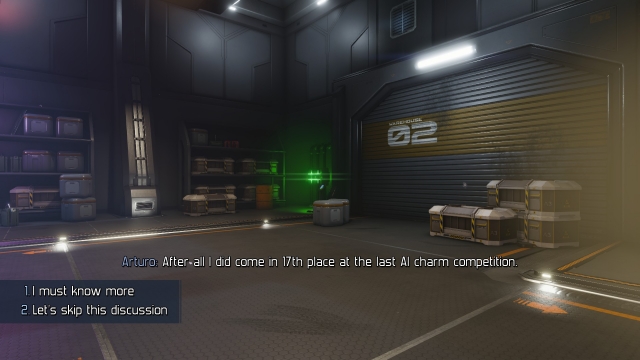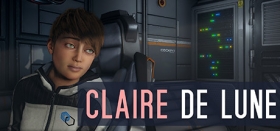
Claire de Lune Review
Claire de Lune is a first-person puzzle platformer that follows John, a smuggler in the sci-fi future of 2191, on his mission to rescue his teenage daughter Claire after their spaceship crashes on a foreign planet. Accompanied – in a sense – by Arturo, the spaceship’s AI, John must pass over chasms and through treacherous terrain with nothing but his trusty nanogun. In the later chapters, John arrives at a medical research facility where, apparently now severely injured, Claire has been taken to by a search team. Naturally, everything has gone horrifically wrong, there’s next to no other human life anywhere, and he is left to navigate through the many security protocols and the scheming facility AI to finally find and save Claire.
The nanogun is the main puzzle-solving device for the game. To explain as simply as possible, it creates nanomatter objects that you can use to assist in getting yourself from point A to point B. You start off being able to spawn only a simple cube, and gain an additional three objects over the game’s course: a booster (basically a trampoline), an attractor and a repulsor. You can only spawn a single instance of each object at once, but you can also freely remove them. Using your nanomatter objects creatively is key to progressing through each area, and the difficulty of the path forward can be anywhere between “straightforward” and “taxing on the brain”. Unfortunately, there tends to be only one or maybe two solutions to any given platforming sequence. In addition, many higher sections of the environment are blocked off by invisible walls, rendering some seemingly promising alternative routes unusable.

In addition to the exploration and platforming sections, there are several smaller minigame puzzles. These tend to only take a minute or two at most and range from “input the code” to “solve the cipher”. Even if you don’t know how to solve a given minigame, clicking around will often help. Codes are always found within the vicinity of their input location.
It is possible to explore the outside environments a little, but for the most part that exploration is futile – there is very little to be found outside of a small set of collectibles in often obscure locations, and the rare achievement. These collectibles add nothing to the story, and only slightly to the lore. If you insist on exploring, you’re likely to find yourself blocked by the invisible walls, and almost certainly you’ll fall to your death a lot.
The characters are a little lacking in depth – you don’t interact with Claire for most of the game, but what screen time she does have feels rather devoid of personality and emotion. John is similarly bland and appears to be disconnected from what is going on around him; he’s lost his daughter, yet he hardly gets frustrated or worried to more than a basic degree. He does seem to have untapped potential in his backstory however, and it would have been interesting to learn more of it outside of a small handful of forgettable flashbacks. Arturo makes up for it to a degree though, with repeated attempts to cheer John along with “fun facts” and questionable intentions. At various points while exploring, and more so once you reach the facility, there is banter between John and Arturo. For many of these, you can respond in one of two ways. These responses don’t change anything with the story, but instead allow you to inject a little personality into John. The witty/sarcastic style responses, while humorous, tend to feel out of place for the situation John is in. Of course, that didn’t stop me from picking every one of them, especially when they’re labelled “obvious dad joke”!

One of the first things my ears picked up upon starting a new game was that the voiceovers were very slightly distorted, as if they were too loud in the original recording. Altering the volume didn’t change anything, but luckily the issue didn’t last very long – certainly no longer than the spaceship section.
Aside from this small niggle, there is often little going on audibly for the most part. The background music feels minimal but fitting, taking a bit of a backdrop to the visuals. Areas of increased action are accompanied by music more suited to keeping you on edge, even when there is nothing apparent happening, which keeps you alert and looking around to see where the danger is.
For every minor negative I’ve listed so far, the graphics department blows it away. This game looks absolutely gorgeous, with so much of the scenery given a lot of care and attention. Really, the only negative thing I can say here is how much a shame it is that I couldn’t explore it all, due to the invisible walls mentioned previously.

Some walls are more obvious than others...
All in all, Claire de Lune is a fun game – it has some tricky sections to be sure, but you can work them out by taking a step back and thinking, by just throwing yourself into the abyss with a vague plan, or by shooting nanomatter objects everywhere and seeing what works. There was one section I felt lost enough to look up how to progress, but seeing the answer did make me wonder why I hadn’t thought of it myself. There’s not much reason to play it beyond the first time though, unless you are an achievement hunter, and for the time spent on your first playthrough – for me, a slow-going eight hours – getting your money's worth may be an issue at full price.
Claire de Lune (Reviewed on Windows)
This game is good, with a few negatives.
Claire de Lune is a great take on the genre, but sadly is somewhat marred by a couple of small but consistent flaws.









COMMENTS